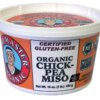Miso Master Organic Brown Rice Miso
$14.60
Miso Master Organic Brown Rice Miso is considered a Long-Term miso. We don’t use the word “Traditional” with this variety because Japanese miso makers never made miso using brown rice, but our methods here are the same as with our other two Long-Term Misos. This is our longest aged, darkest, strongest, and richest miso.
Made in USA. Aged a minimum of 24 months. Unpasteurized, refrigerate. Refrigerated shelf life about 18 months.
For centuries Japanese craftsmen have used natural fermentation to transform soybeans and grains into many types of miso, the rich, thick paste used for flavoring a wide variety of dishes. Though now almost extinct in Japan, these ancient practices have been in constant use since 1980 at the American Miso Company, the largest traditional miso works in the world. This traditional method results in superior quality miso. Fresh and unpasteurized, it has subtle, balanced flavors that only great care, high quality ingredients, and natural aging can produce. Our years of experience in artisanal organic miso-making make Miso Master the finest miso in the world.
Miso Master Organic Brown Rice Miso is considered a Long-Term miso. We don’t use the word “Traditional” with this variety because Japanese miso makers never made miso using brown rice, but our methods here are the same as with our other two Long-Term Misos. This is our longest aged, darkest, strongest, and richest miso. It is aged naturally without temperature control for a minimum of 2 full years in giant four-ton, hand-crafted Cypress, Redwood, or Fir barrels. It has a high soybean content in relation to the brown rice koji (grain innoculated with aspergillus spores). Because soybeans are difficult to ferment, with their high protein and fat content, this miso variety requires a prolonged aging period, giving the aspergillus spores and lactobacillus bacteria time to break down the complex protein and fat molecules into their more digestible constituents.
Long-Term aged misos also have a higher salt content which retards the fermentation so that the process moves gradually. Miso Master Organic Brown Rice Miso has a complex flavor profile that is salty, savory, and mildly sweet. These long-term misos are the cask-aged Bordeaux Wines of miso. But the story does not end with just a rich taste, for these misos have their own special health benefits.
Soybeans are the main source of the potent phytoestrogens known as isoflavones which have been shown to effectively combat degenerative diseases such as cancer, heart disease, and osteoporosis. All isoflavones, however, are not created as equally potent antioxidants. The isoflavones found in soybeans and unfermented soybean products such as soymilk, tofu, soy supplement powders, soy flakes, and TVP are mainly isoflavone glucosides, which cannot be absorbed intact into the human bloodstream.
Only another isoflavone subgroup, the isoflavone aglycones -which include the famous anticancer powerhouses geninstein and diadzein- can be absorbed intact into the human bloodstream. These isoflavone aglycones are found in meaningful concentrations only in fermented soybean foods such as miso, soy sauce (shoyu and tamari), tempeh, and natto. During fermentation as much as 90% of the isoflavone glucosides are converted into isoflavone aglycones. Long-Term Aged Misos also contain melanoidins, another powerful antioxidant group. These melanoidins are the pigments that give Long-Term Aged Misos their dark colors.
SIZES: 8 oz | 16 oz | 4 lb | 15 lb | 40 lb
| Weight | N/A |
|---|
Only logged in customers who have purchased this product may leave a review.
Related products
Organic Pantry
Organic Pantry
Organic Pantry
Organic Pantry
Organic Pantry
Organic Pantry
Organic Pantry
Organic Pantry













Reviews
There are no reviews yet.